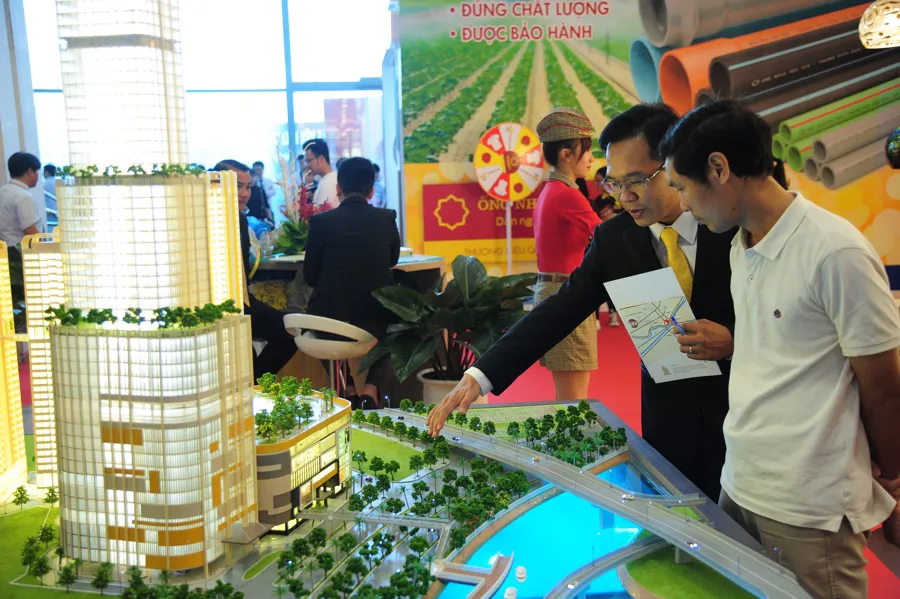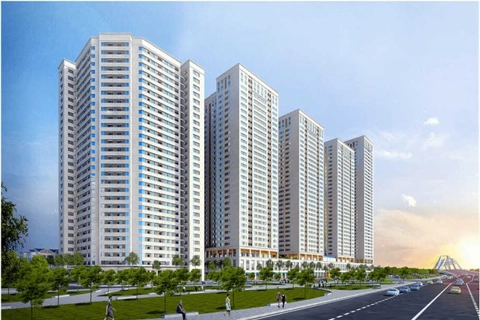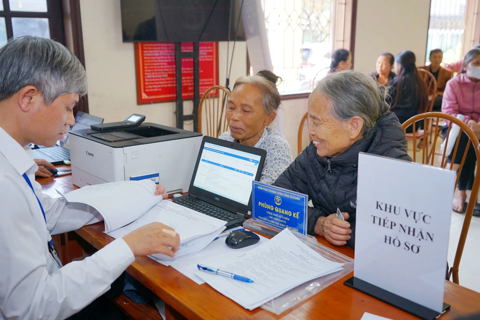Real estate prices are on the rise in downtown Hanoi
Demand for retail space in alleyways is rising as small and medium-sized enterprises seek to cut costs, given that most of their revenues come from e-commerce platforms.
As the economy recovers, favorable interest rates and the lessons learned from past price rises, such as "the longer you wait, the higher the price," provide greater motivation for homebuyers. This has led to increased demand for residential properties in recent times.
| Buyers look at a real estate project in Hanoi. Photo: Cong Hung/The Hanoi Times |
With limited supply, prices for primary apartments in Hanoi remain high, with newly launched projects being in the premium segment. Meanwhile, secondary apartments priced at around VND3 billion (US$120,000) each, mainly in the suburbs, are becoming increasingly scarce and in demand. A private house priced at around VND4 billion ($160,000) with an area of 30-40 square meters has become an attractive option for many families looking to settle down.
Remarkably, the rise in prices is also fueled by investment demand. Alley houses are seen as liquid assets with title deeds (unlike many houses in Hanoi, which lack title deeds or face a lengthy process to obtain them) and affordable prices. They offer high rental yields in the context of rising demand for residential property. Moreover, there is a growing demand for retail space in small alleyways as small and medium enterprises seek to cut costs, given that most of their revenue comes from e-commerce platforms.
According to data from the real estate website batdongsan.com.vn, interest in and transactions of private houses in Hanoi have gradually improved in the first quarter of 2024. Notably, there has been a significant increase in interest in some suburban districts, as central districts no longer offer many choices.
Market research data from the Vietnam Association of Realtors (VARS) indicates that the prices of individual houses being transacted have increased by 5-15% compared to the end of 2023. While this price rise shows signs of irregularity, it is undeniable that there is significant interest. In particular, in the first quarter of 2024, some real estate agents recorded the highest number of individual house transactions in the past five years.
"The private residential market is establishing a new price level as supply continues to lag behind demand from investors and residents, particularly with the ongoing urbanization trend," said Nguyen Chi Thanh, Vice Chairman of VARS.
He advises that inner-city house prices are unlikely to fall, and those with genuine needs should consider purchasing a house if they find a product that suits their financial capabilities without excessive borrowing.
He also noted that the price trend of Hanoi's residential real estate mirrored the price increase in the apartment segment from late 2021 to mid-2022 when the market faced difficulties. Although prices fell during challenging times, they quickly rebounded. Interest in individual houses remained stable even during the downturn.
"Aside from small individual houses, apartment buildings in alleyways are also heating up as the number of tenants and buyers of mini-apartments gradually recovers," he added. This trend, combined with individual housing, puts pressure on urban infrastructure, leading to congestion and associated risks such as fire hazards. Unlike commercial housing developments, which are subject to complex procedures, these apartments require minimal infrastructure, with little room for transport or green spaces.
Advancing social housing projects
Insiders have said that to address the housing challenges faced by residents and alleviate urban overload, the state needs robust policy solutions to develop social housing in urban areas, improve planning and construction approval processes, and promote public investment to shift demand from central areas to surrounding provinces and regions with more affordable prices and greater land resources. The state should also encourage the development of affordable commercial housing.
"The most viable solution is to develop large cities vertically, replacing terraced houses with high-rise apartments. This aligns with development trends in more advanced countries, where new construction in recent years has consisted mainly of high-rise apartments," said Dr. Nguyen Van Dinh, Vice President of the Vietnam Real Estate Association.
Meanwhile, architect Pham Thanh Tung, Chief of Staff at the Vietnam Association of Architects, pointed out that the government's social housing policy has been in place since 2009. Still, in most urban areas, particularly Hanoi and Ho Chi Minh City, social housing projects are mostly integrated into commercial housing developments. Land and infrastructure, especially public transport infrastructure for social housing, have not been given sufficient attention.
"Social housing development has faced many challenges, especially in terms of land allocation and the construction of public transport infrastructure to facilitate access to social housing neighborhoods. Moving forward, we need to learn from these experiences. Additionally, regulatory agencies need to reconsider the mandatory 20% land reserve in commercial housing projects for the construction of social housing. Moreover, the planning principle for social housing projects is that they should not be too far from the center and should have sufficient infrastructure, especially public transport," Tung emphasized.











